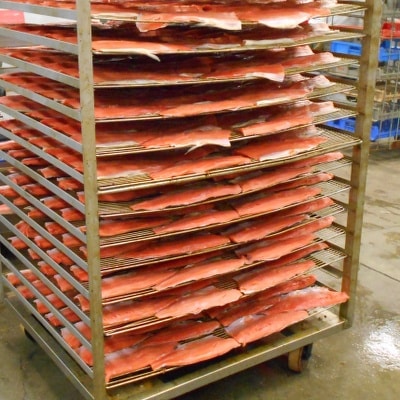Smoking Salmon: The Next Step In The Retort Process
Brining Wild Alaskan Salmon
After we fillet and trim the fish, Brining and Smoking Salmon is the next step in preparing for the retort process. Each species of salmon has a slightly different brine absorption rate. Each species also requires different amounts of smoking time in order to produce the best quality product. For this reason, we separate our salmon by species and brine and smoke it separately. The brine solution that we use on our product is a proprietary salt and brown sugar mixture, that when combined with the Alderwood smoke provides the perfect flavor profile.
Often times manufacturers will use either a very high or very low salt content in their brine. They do this to save time (more salt requires less brine time) or materials. We use more of a mid-line brine to ensure the fish floats in the brine solution and not on top or underneath it. While this may use more material, or take more time, it provides a more consistent salt level throughout the salmon.
Smoking Wild Alaskan Salmon
The next step is Smoking the Wild Alaskan Salmon. In this process, we use a commercial grade horizontal flow smoker, made by Enviro-Pak. Laying the fillets flat on the smokehouse rack system allows enough room for an even layer of Alderwood smoke to pass across the top and bottom of each fillet giving it a perfect seal of smoke locking in the flavor. After the smoking cycle is complete, the smokehouse runs it through a drying cycle to dehydrate excess moisture. Drying the salmon too much can affect the flavor profile and texture resulting in a “tough” product. Conversely, under-drying the salmon leaves it wet and mushy, also producing an undesirable product. Our Enviro-Pak smoker and experienced crew target a specific moisture content to produce a consistently high-quality product every time.




Leave A Comment